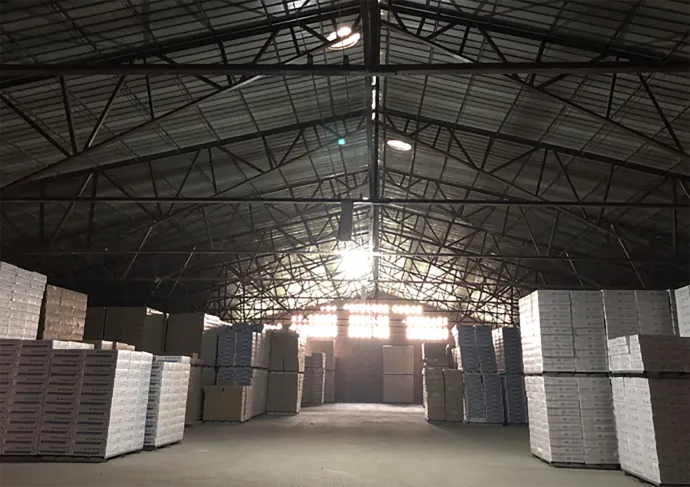Oct . 19, 2024 01:50 Back to list
Explore the Benefits and Uses of T Grid Ceiling Systems in Modern Interiors
Exploring the T-Grid Ceiling Design Innovation and Practical Applications
In the realm of modern architectural design and interior construction, the T-grid ceiling has emerged as a prominent feature that merges aesthetics with functionality. This system, characterized by its grid-like framework, offers a versatile solution for creating visually pleasing and practical ceiling spaces in various environments—from office buildings to retail spaces and educational institutions.
Understanding the T-Grid Ceiling
The T-grid ceiling, also known as a suspended or drop ceiling, consists of a network of metal grid channels that form a structural support for ceiling tiles. The design typically comprises T-shaped cross sections, giving it the name T-grid. These grids can accommodate various materials, allowing for a plethora of design choices including different textures, colors, and acoustical properties. This adaptability makes T-grid ceilings an attractive option for architects and interior designers seeking to balance form and function.
Advantages of T-Grid Ceilings
There are several advantages to incorporating T-grid ceilings in construction projects. First and foremost, they provide excellent thermal and acoustic insulation, contributing to a more comfortable indoor environment. The space above the ceiling can also serve as an essential area for housing electrical wiring, air ducts, and plumbing, efficiently organizing utilities while keeping them out of sight.
Moreover, T-grid ceilings facilitate maintenance and repairs. Should a tile become stained or damaged, it can be easily replaced without affecting the entire ceiling system. This accessibility is particularly beneficial in commercial spaces where downtime can lead to financial losses. Additionally, these ceilings can also accommodate various lighting fixtures, enhancing the overall ambiance of a space while providing necessary illumination.
Design Flexibility and Aesthetic Appeal
t grid ceiling

Beyond their functional benefits, T-grid ceilings offer remarkable design flexibility. The grid system allows for the incorporation of different ceiling types—such as coffered ceilings, layered designs, or even custom shapes—enabling architects to exercise their creativity. By selecting different tile materials, finishes, and colors, designers can create unique atmospheres tailored to specific projects. For instance, in educational environments, bright and engaging colors can stimulate creativity, while in corporate offices, subdued tones may foster a professional atmosphere.
The ability to integrate various textures—such as acoustical tiles, plaster, or wood—further enhances the aesthetic appeal. This diversity allows for a striking visual contrast against the structural elements of a building, creating a dynamic interplay between the ceiling and the walls.
Environmental Considerations
With a growing emphasis on sustainability in design, T-grid ceilings have taken on an additional role. Many manufacturers now produce ceiling tiles from recycled materials, contributing to LEED certification points in green buildings. Moreover, the use of energy-efficient lighting systems within the grid can significantly reduce a building's overall energy consumption.
Conclusion
The T-grid ceiling is more than just a practical solution for covering unsightly infrastructure; it represents a merging of innovation, flexibility, and sustainability in architectural design. Its numerous benefits—ranging from ease of installation and maintenance to aesthetic versatility—make it an invaluable asset in various commercial and residential settings. As architects and designers continue to explore new materials and technologies, the T-grid ceiling is likely to remain a vital component of modern construction practices, evolving to meet the demands of future design challenges while enhancing the quality and functionality of interior spaces. Going forward, the interplay between creativity and practicality will keep the T-grid ceiling at the forefront of architectural trends for years to come.
In conclusion, whether used in a high-rise office building, a bustling retail store, or a serene educational space, the T-grid ceiling stands as a testament to thoughtful design, seamlessly blending utility with elegance in our built environments.
-
Durable Ceiling T Grid Systems | Easy InstallationNewsAug.29,2025
-
PVC Gypsum Ceiling: Durable, Laminated Tiles for Modern SpacesNewsAug.28,2025
-
Pvc Gypsum Ceiling Is DurableNewsAug.21,2025
-
Mineral Fiber Board Is DurableNewsAug.21,2025
-
Ceiling Tile Clip Reusable DesignNewsAug.21,2025
-
Ceiling T Grid Modular DesignNewsAug.21,2025







